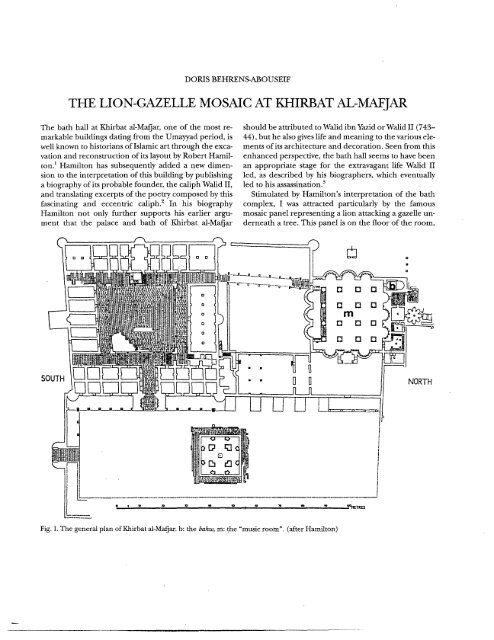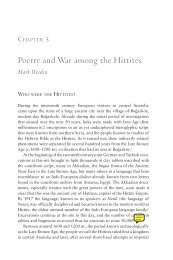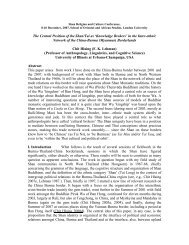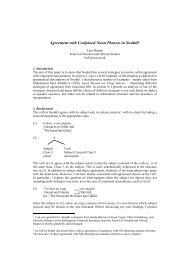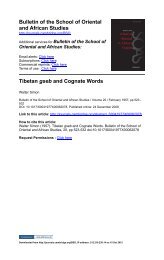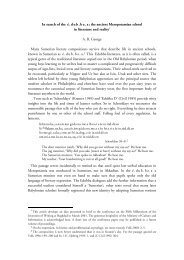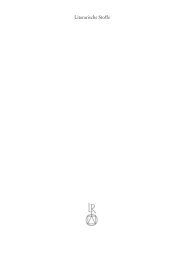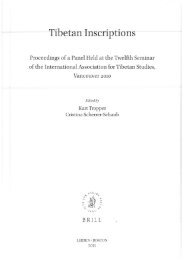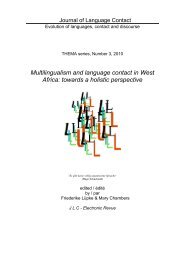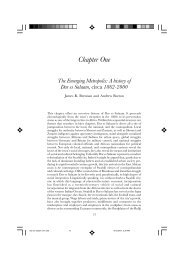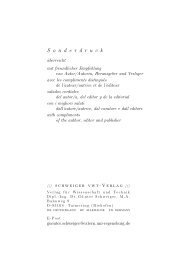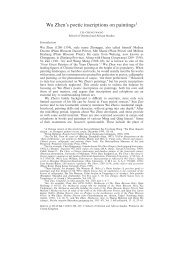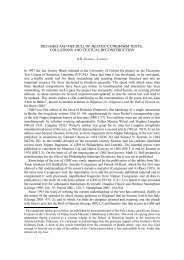THE LION-GAZELLE MOSAIC AT KHIRBAT AL-MAFJAR
THE LION-GAZELLE MOSAIC AT KHIRBAT AL-MAFJAR
THE LION-GAZELLE MOSAIC AT KHIRBAT AL-MAFJAR
You also want an ePaper? Increase the reach of your titles
YUMPU automatically turns print PDFs into web optimized ePapers that Google loves.
DORIS BEHRENS-ABOUSEIF<br />
<strong>THE</strong> <strong>LION</strong>-<strong>GAZELLE</strong> <strong>MOSAIC</strong> <strong>AT</strong> KHIRB<strong>AT</strong> <strong>AL</strong>-<strong>MAFJAR</strong><br />
The bath hall at Khirbat al-Mafjar, one of the most remarkable<br />
buildings dating from the Umayyad period, is<br />
well known to historians of Islamic art through the excavation<br />
and reconstruction of its layout by Robert Hamilton.'<br />
Hamilton has subsequently added a new dimension<br />
to the interpretation of this building by publishing<br />
a biography of its probable founder, the caliph Walid II,<br />
and translating excerpts of the poetry composed by this<br />
fascinating and eccentric caliph. 2 In his biography<br />
Hamilton not only further supports his earlier argument<br />
that the palace and bath of Khirbat al-Mafjar<br />
Fig. 1. The general plan of Khirbat al-Maijar. b: the bahw, m: the "music room". (after Hamilton)<br />
111 _<br />
should be attributed to Walid ibn Yazid or Walid II (743-<br />
44), but he also gives life and meaning to the various elements<br />
of its architecture and decoration. Seen from this<br />
enhanced perspective, the bath hall seems to have been<br />
an appropriate stage for the extravagant life Walid II<br />
led, as described by his biographers, which eventually<br />
led to his assassination. 3<br />
Stimulated by Hamilton's interpretation of the bath<br />
complex, I was attracted particularly by the famous<br />
mosaic panel representing a lion attacking a gazelle underneath<br />
a tree. This panel is on the floor of the room,
12<br />
which, following Walid's biographical sources, Hamilton<br />
calls a bahw, meaning reception hall, and which he<br />
identifies as a private room (fig. 1).<br />
Walid II, the patron of Khirbat al-Mafjar, and the son<br />
of the caliph Yazid, is described in the sources as what<br />
one might today call a playboy (khalif). He was also an<br />
athlete and huntsman of great talent and an important<br />
poet who had a significant impact on the style of Arab<br />
poetry in the subsequent period, especially on the work<br />
of Abu Nuwas (died ca. 815). 4 Poetry at that time was<br />
often sung, and Walid's dedication to poetry was complemented<br />
by his passion and talent for music. He surrounded<br />
himself with poets, musicians, and dancers.<br />
Inspired by this aspect of his life Hamilton designated<br />
the vaulted hall that adjoins the bath proper as the "music<br />
room," noting that there was an "unmistakable resonance<br />
between the defiant and often humorous eccentricity<br />
of Walid and peculiar features discernible in the<br />
buildings."<br />
The hall is reached from a projecting porch; sixteen<br />
pillars support the vaults of its roof. The porch was<br />
richly adorned with stucco floral motifs and representations<br />
of athletes, half-naked girls, gazelles, and sheep. A<br />
Fig. 2. The bahw, restored perspective. (after Hamilton)<br />
_ 1_1_<br />
DORIS BEHRENS-ABOUSEIF<br />
central niche was intended for a stucco statue of the caliph<br />
(most likely the caliph in spe at the time the bath<br />
was erected) standing above a pair of lions. On each of<br />
three sides of the hall three apses were once roofed by<br />
half-domes. These nine apses and two others flanking<br />
the porch entrance, making a total of eleven, complete<br />
the layout. The hall's floor was composed of a patchwork<br />
of mosaic panels in a large variety of geometric patterns<br />
that rarely repeat. The central mosaic "carpet"<br />
that was once surmounted by the central dome is correspondingly<br />
circular. The complex was never completed;<br />
it was destroyed by an earthquake in 746 shortly after it<br />
was built. Only the mosaic pavement remains in its original<br />
condition.<br />
Appended to the music room on the north were the<br />
bath and four rooms; on the south a few steps led down<br />
to a long plunge pool.<br />
At the northwestern corner of the music room, adjacent<br />
to the structures of the steam bath, is the small absidal<br />
room or bahw (fig. 2). Its floor is covered by two<br />
mosaic panels - one rectangular with a geometric<br />
design, and the other an arched panel filling the slightly<br />
elevated floor of an apse. The arched panel has the representation<br />
of the lion attacking the gazelle (fig. 3). It is<br />
the only mosaic panel in the complex that has a figural<br />
motif, suggesting that this motif had a symbolic meaning<br />
of particular significance.<br />
At the pictorial center of the mosaic is a large tree<br />
bearing fruit that look like apples. The foliage of the<br />
tree seems to grow on both sides from two vertical parallel<br />
trunks connected by a smaller branch. The viewer<br />
looking into the room can see the lion attacking a<br />
gazelle on his right side underneath the tree. On the left<br />
side two other gazelles are grazing.<br />
Ettinghausen, in his article "The Conquering Lion,"<br />
saw the mosaic as a symbol of royalty. Later, in his<br />
"Throne and Banquet Hall," he added a more political<br />
dimension to this interpretation, 5 identifying the room<br />
as a "throne room" and the image itself as a representation<br />
of ddr al-isldm, the Muslim world, symbolized by the<br />
two grazing gazelles, in opposition to the ddr al-harb, the<br />
world outside the realm of Islam, symbolized by the<br />
attacking lion, basing this interpretation on an analogy<br />
with the Christian iconography of opposing good and<br />
evil. Such a political interpretation is, however, not consistent<br />
with the mosaic's location in an almost hidden<br />
corner of the music room, adjacent to the bath rooms,<br />
i.e., in a place that was obviously a very private, even<br />
intimate, section of the palace complex. The symbol of<br />
Islam and the world seen by Ettinghausen would require
Fig. 3. The lion-gazelle mosaic. (after Hamilton)<br />
a more ceremonial and central setting, indeed a throne<br />
room, which this bahw by no means could have been.<br />
Hamilton's interpretation of the bahw as a private room<br />
is therefore more plausible, and poses no problem for<br />
Ettinghausen's earlier version that the lion motif symbolizes<br />
royalty. The panel was designed to express the<br />
private character of the room as well as the royal character<br />
of its master.<br />
As has been demonstrated by Hartner and Ettinghausen,<br />
the theme of the "conquering lion" is a very old<br />
one, dating to ancient Mesopotamia and Iran. Throughout<br />
the centuries it was given a multitude of meanings<br />
that evolved over time and place. In the Iranian world it<br />
was an astronomical symbol for the constellations of Leo<br />
and Taurus. The triumphant lion (Leo being the domicile<br />
of the sun) destroys the bull, thus allowing the sun<br />
to reappear and spring to follow winter. According to<br />
Hartner and Ettinghausen, the astronomical symbol<br />
may later have given way to the more political meaning<br />
of power and royalty.<br />
___r_________l____l_____ I<br />
<strong>THE</strong> <strong>LION</strong>-<strong>GAZELLE</strong> <strong>MOSAIC</strong> <strong>AT</strong> KHIRB<strong>AT</strong> <strong>AL</strong>-<strong>MAFJAR</strong><br />
13<br />
In ancient Mesopotamian and Iranian images, the<br />
lion is fighting with a sizable animal, usually a bull but<br />
sometimes also a stag or a deer of the lion's size, to make<br />
the combat appear to be between two equal powers, an<br />
expression of the summer-winter cycle (fig. 4). In classical<br />
and in Byzantine art we find this motif slightly modified<br />
with a lion attacking a large horse. 6<br />
Mosaics from the Byzantine period in Syria and Jordan<br />
brought to light by recent excavations show that,<br />
despite regional variations, hunting scenes, including<br />
that of a lion pursuing a stag, were everywhere a favorite<br />
motif for mosaic pavements. In addition to the hunting<br />
scenes, there are also other types of zoomorphic<br />
representations showing wild and tame animals, sideby-side<br />
in a peaceful context. 7 In the Transjordanian socalled<br />
Madaba school of mosaics, where geometric patterns<br />
occupy an important place, the figural themes<br />
display a narrative tendency in the representations of<br />
hunting scenes and country life. Both the geometric<br />
mosaic carpets of Khirbat al-Mafjar and the wall paint-
14<br />
Fig. 4. Relief in Persepolis with lion attacking a bull.<br />
ings of Qusayr Amra seem to have their roots here. 8<br />
The peaceful cohabitation of a lion and other animals<br />
appears both in northern Syria and in Transjordan. A<br />
lion faces a bull on a sixth-centuryAntioch mosaic panel<br />
mentioned by Ettinghausen.9 As at Khirbat al-Mafjar, a<br />
tree with fruit is in the center of the picture. On the<br />
right side underneath the tree a bull stands facing a lion<br />
advancing from the left. An inscription on the tree indicates<br />
that the image represents peace between enemies,<br />
an illustration of a Messianic vision of paradise: "The<br />
lion and the ox shall eat straw together" (Isaiah 62:25).<br />
We find this motif on mosaic pavements at Madaba and<br />
in a church at Macin in Jordan dated 719-20, i.e., from<br />
the Umayyad period, with the same inscription.' 0<br />
At Khirbat al-Mafjar, a significant element seems to<br />
suggest that the lion is not as dangerous as he first<br />
appears. In all the early representations of the conquering<br />
lion, the prey stands alone against the lion, whereas<br />
at the bahw the gazelle is accompanied by two others<br />
who do not seem at all disturbed by the lion's presence.<br />
They make no effort to escape, in contrast to so many<br />
hunting scenes in pre-Islamic and Islamic art where the<br />
pursued animals run for their lives ahead of the hunter.<br />
Here their bodies are directed toward the attacking<br />
lion, and their posture and attitude have no suggestion<br />
of the lion as threat.<br />
A further argument for the interpretation of the lion<br />
motif as non-belligerent is the orientation of the panel,<br />
a point that Ettinghausen has already raised. The image,<br />
DORIS BEHRENS-ABOUSEIF<br />
however, is not oriented, as Ettinghausen claimed, to<br />
face someone seated in the apse and facing the<br />
entrance, but rather to face someone entering the<br />
room. To someone looking from within the apse, the<br />
tree would appear upside-down; to someone coming<br />
into the room, the scene is upright. In this case the lion<br />
is on the right-hand side. As Ettinghausen observed, in<br />
Christian iconography the right side is auspicious in<br />
contrast to the left." There is unequivocal evidence that<br />
the same is also true in Umayyad culture and poetry.<br />
Walid himself expressed this idea on more than one<br />
occasion. In one poem, he says:<br />
We caught and would have killed an antelope<br />
That ran auspicious from the right.' 2<br />
And elsewhere, in Walid's poetry:<br />
_ I_ _I<br />
Pass the cup round to the right<br />
Don't pass it to the left!`'<br />
By placing the lion on the right-hand side of the viewer,<br />
the artist made it clear that the lion was auspicious without,<br />
however, implying a negative association with the<br />
left side. If we are to look for an antithesis between the<br />
two sides of the image, it is not good and evil that we<br />
should expect to find in a private room within a bath<br />
complex, but rather strength and weakness, or perhaps<br />
more particularly, the male symbolized by a "conquer-
ing lion" and the female symbolized by the graceful<br />
gazelles.<br />
Looking at the lion's prey, the gazelle, the most striking<br />
feature about its appearance is its delicate and graceful<br />
form, the slender body with a long neck and the<br />
finely shaped head. If the figure represents gender, this<br />
should be female beauty, as opposed to the virile features<br />
associated with a bull or a stag. The gazelles are obviously<br />
smaller than the lion, making combat between<br />
them patently uneven.<br />
Anyone familiar with Arab poetry or Arab poetical<br />
forms, old or contemporary, will appreciate that the<br />
gazelle in Arabic culture, in both literary and colloquial<br />
language, is a symbol of female beauty. Its comparison<br />
with the beloved is "one of the major topoi of traditional<br />
Arabic love poetry." 4 Some linguists even relate the<br />
word ghazdl (gazelle) with ghazal (love poetry) .1 The virgins<br />
of Paradise, the houris, are by definition girls with<br />
large eyes similar to those of the gazelles.'<br />
Walid II himself wrote a poem that includes this<br />
image:<br />
Salmd my love, an antelope I love<br />
For the dark eyes and spotless neck and throat. 7<br />
Besides being a symbol of female beauty, the antelope or<br />
gazelle was celebrated repeatedly in Arab hunting poetry<br />
of the pre-Islamic orJahiliyya and the Umayyad periods<br />
as a beautiful animal of prey whose elegance and<br />
swiftness fascinated the hunter and seduced him to pursue<br />
it. In the literature dealing with the interpretation of<br />
dreams, one finds interesting information in this context.<br />
In the section on the interpretation of dreams,<br />
acquiring a gazelle by hunting techniques equals<br />
becoming the owner of a slave-girl by way of ruse or<br />
fraud, or marrying a wife. Killing the gazelle symbolizes<br />
deflowering a slave girl.' 8<br />
Walid, as patron of Khirbat al-Mafjar, poet, huntsman,<br />
and womanizer, dedicated most of his poetry to wine<br />
and love. In one poem about a hunting excursion, Walid<br />
pursued an antelope, but stopped short of killing her after<br />
he looked at her neck and her eyes which reminded<br />
him of his beloved Salma:<br />
We caught and would have killed an antelope<br />
That ran auspiciously to the right.<br />
But then it gently turned its eyes and looked -<br />
The very image of your look!<br />
We let it go. Were it not for our love<br />
For you, it surely would have died.<br />
Now, little antelope, you're free and safe.<br />
<strong>THE</strong> <strong>LION</strong>-<strong>GAZELLE</strong> <strong>MOSAIC</strong> <strong>AT</strong> KHIRB<strong>AT</strong> <strong>AL</strong>-<strong>MAFJAR</strong><br />
So off you go,<br />
Happy among the other antelopes.'<br />
At first glance, Walid looks at an antelope and sees his<br />
prey. On the second look, however, he recognizes his<br />
beloved Salma and the hunter becomes the lover.<br />
It is tempting to see the mosaic panel of the bahw as an<br />
illustration of this episode: on the right side the hunter<br />
pursues his prey; on the left side, the antelope or gazelle<br />
returns to her companions. A variation on this motif in<br />
other sources mentions that the caliph Abd al-Malik ibn<br />
Marawan is said to have let a gazelle escape after he cap-<br />
2 0<br />
tured her because of her resemblance to his beloved:<br />
O likeness of Layli, never fear!<br />
For I am your friend, today, O wild deer!<br />
Then I say, after freeing her from her fetters:<br />
You are free for the sake of Layla, for ever!<br />
The hunter freeing a gazelle is a related topos. Bfirgel<br />
refers to a poem in Kitrb al-Aghdnfin which the husband<br />
of the beloved woman turns into a wolf and kills the<br />
gazelle, but is himself killed by the vengeful hunter. Another<br />
related motif frequently used in the poetry of<br />
Bashshar ibn Burd (715-83), shows the reverse situation:<br />
the hunter is himself killed by love sickness for the<br />
deer. Bfirgel relates the image of the murderous glances<br />
of the gazelle back to an ancient Arabian tradition that<br />
attributes magic qualities to the bovine animal. Thus the<br />
gazelle may be attacked by the hunter, but she has her<br />
own deadly weapons.21 This establishes an equilibrium<br />
of power which may explain the serenity of the two<br />
gazelles grazing on the left-hand side of our mosaic<br />
panel. It may be going too far, perhaps, to see them as<br />
awaiting their turn.<br />
A lion chased by a graceful gazelle! Never before<br />
did you see a gazelle hunt a lion! 22<br />
Two centuries later the poet al-Sanawbari (d. 945) wrote<br />
two verses on the women of the city of Raqqa with a similar<br />
theme:<br />
We may have hunted her gazelles one day<br />
Her gazelles hunted our hearts forever."<br />
15<br />
The lion, in Arabic as in other literature, is a symbol of<br />
strength, courage, and royalty, an image that has ancient<br />
origins. 24 The statue of Walid once standing in a niche<br />
above the porch shows him with a pair of heraldic lions<br />
at his feet. It is not difficult to imagine that Walid identi-
__<br />
16<br />
fled himself- or was identified - with a lion. Ironically,<br />
in a poem referring to Walid's assassination, the caliph<br />
is compared with a lion in whose body the spears<br />
are breaking.<br />
2 5<br />
It seems, therefore, that the artist of the bahw mosaic<br />
modified a current motif and adapted a familiar iconography<br />
to conform to the location and purpose of the<br />
building for which it was designed. Interpreting the lion<br />
mosaic as having an erotic meaning would suit the private<br />
character of the bahw and its location within the<br />
complex. The function of the room as chambre separie in<br />
this hedonistic setting would conform with the orgiastic<br />
scenes narrated by Walid's biographers. It does not<br />
require much imagination to assume that when he withdrew<br />
into this room he was not alone.<br />
If we look closely at the fruit tree in whose shade the<br />
action takes place, we can see that its two branches are<br />
entangled in a manner that suggests an erotic embrace.<br />
Here again, a poem by Walid addressed to his beloved<br />
Salma seems to support this interpretation. The comparison<br />
of the beloved woman with a garden or a para-<br />
2 6<br />
dise is another theme used in early Arab poetry:<br />
and elsewhere:<br />
For Salma is my little garden and my bliss. 2 7<br />
Salma, you were a paradise, and its fruits<br />
In all their kinds near ripe for harvesting. 28<br />
Walid goes on with his description of the beloved garden<br />
after Salma died, with the following verse: "Its fruits<br />
were scattered by the autumn winds." The word used in<br />
the poem for paradise is janna, which means also garden;<br />
"fruits near ripe for harvesting" are in fact represented<br />
in the tree of our mosaic panel, so that here, too,<br />
the idea of paradise is near. The juxtaposition of two<br />
images - the gazelle and the garden - is absolutely<br />
consistent with the Arabic poetical tradition of having<br />
every feature of the beloved woman associated with a<br />
metaphor of its own.<br />
According to Hamilton's reconstruction, the rectangular<br />
part of the bahw outside the apse was covered with<br />
a dome. Underneath the dome was a painted stucco<br />
frieze showing a row of partridges (see fig. 2). In Greek<br />
tradition the partridge was associated with sexuality, as<br />
Aristotle wrote in his Historia Animalium. 29 It is quite<br />
likely that this same symbolism was attached to the partridge<br />
representations in the bahw. The multiple representation<br />
of this bird in the bahw would seem to provide<br />
DORIS BEHRENS-ABOUSEIF<br />
additional support for the interpretation of the erotic<br />
iconography of the mosaic panel.<br />
Another detail of this mosaic panel sheds further light<br />
on its meaning. The border of the panel imitates the tassels<br />
of a textile of the kind used for draperies, clothes, or<br />
curtains. s 3 This feature, which has no parallel in any<br />
other known Umayyad mosaic, establishes a parallel between<br />
the panel and a type of textile cover. We know<br />
from various accounts of the ceremonial of the Umayyads,<br />
Abbasids, and Fatimids that the caliphs sat behind<br />
curtains from where they appeared at specified<br />
moments in the ritual. Walid is reported to have sat<br />
behind a curtain listening to music or poetry. Singers<br />
and musicians traditionally performed behind curtains.<br />
The bahw at Khirbat al-Mafjar most likely was closed off<br />
by curtains, perhaps embroidered or woven with patterns<br />
similar to those on the mosaics. The Sasanian<br />
kings sat in the wintertime beneath curtains representing<br />
garden landscapes to evoke nature's rebirth in<br />
spring. Similarly, in the Fatimid period, the curtains of<br />
palaces are described as having been adorned with representations<br />
of animals and trees.<br />
The border of our mosaic panel, by creating an association<br />
with a curtain or drape, could well have been<br />
intended to suggest that the whole scene depicted has to<br />
be understood in the sense of intimacy. In Arabic the<br />
word satr and other words derived from the same stem<br />
(s-t-r) are used not only to designate the curtain or cover<br />
itself but, by extension in a figurative sense, to refer to<br />
intimacy. In the Arabic medieval literary tradition, closing<br />
a door or a curtain behind a couple is a metaphor<br />
for the sexual act. A hadith text stipulates that whenever<br />
a man withdraws with a woman behind a door or a curtain<br />
he is liable to pay the dowry.3' The literary criticJurjani<br />
(d. 1078) sees in this motif a metaphor that<br />
expresses intimate relations and implies the payment of<br />
a dowry: man arkhad satran aw aghlaqa baban wajaba almahra.<br />
32<br />
The question that now arises is to what extent poetry<br />
or other literary texts can be used to interpret images in<br />
Islamic art. Here we have to note a difference between<br />
the Iranian and the Arab world. In the arts of Iran,<br />
where figural representations never ceased to play a<br />
prominent role in the arts, references to epics and poetical<br />
works are common. For the Arab world, where pictorial<br />
motifs are less frequent, this problem is more<br />
complicated. We are used to seeing epigraphy in Islamic<br />
religious architecture as a medium equivalent to imagery<br />
in other arts. However, the art of the Umayyad period<br />
was still under the impact of pre-Islamic traditions
Fig. 5. The rebus of Walid. (after Hamilton)<br />
and made use of images. If Klaus Brisch's interpretation<br />
of the mosaics of the Umayyad mosque at Damascus is<br />
correct, the patterns illustrated there are closely based<br />
on specific texts in the Qur'an that describe architecture<br />
in paradise. 33 If we go back to pre-Islamic Christian<br />
traditions in this region we find that mosaics were used<br />
to depict literary texts as patterns for architectural decoration.<br />
At St. Mary's Church at Madaba, the so-called<br />
Hyppolitos Hall, attributed to the sixth century, is decorated<br />
with a mosaic pavement illustrating scenes from<br />
Euripides' play, Hyppolitos. 34<br />
Poetry was the major form of art among the pre-<br />
Islamic Arabs, and it was the major form of literature under<br />
the Umayyads. Walid was a poet who, unlike others,<br />
was a royal figure who had the means and power of<br />
<strong>THE</strong> <strong>LION</strong>-<strong>GAZELLE</strong> <strong>MOSAIC</strong> <strong>AT</strong> KHIRB<strong>AT</strong> <strong>AL</strong>-<strong>MAFJAR</strong><br />
______1_III__C____1_______-I___<br />
propagating his poetical ideas through other media.<br />
The illustration of a poetical image in a mosaic panel<br />
would not be exceptional in the context of Khirbat al-<br />
Mafjar; it has a parallel in the representation which<br />
Hamilton identifies as a rebus, and which shows a fruit<br />
sprouting, perhaps the stylized figure of a woman, next<br />
to which is a knife, a masculine symbol (fig. 5). Hamilton<br />
recognized in this rebus the name Walid, which literally<br />
means sprout or newborn.<br />
This and the lion's panel are the only ones in the<br />
mosaic carpet that contain representational images, and<br />
both of them seem to refer in an encoded manner to<br />
the person of Walid. They are somewhat provocative<br />
images of Walid as he liked to present himself.<br />
University of Munich<br />
Munich, Germany<br />
NOTES<br />
17<br />
Author's note: I would like to thank Professor Wolfhart Heinrichs<br />
and Dr. James Montgomery for their generous advice in matters of<br />
Arabic poetry.<br />
1. RW. Hamilton, Khirbat al-Mafjar: An Arabian Mansion in theJordan<br />
Valley (Oxford, 1959); idem, "Who Built Khirbat al-Mafjar?,"<br />
Levant 1 (1969): 61-67; idem, "hirbat al-Mafjar: The<br />
Bath Hall Reconsidered," Levant 10 (1978): 126-38; Oleg Grabar,<br />
"The Umayyad Palace at Khirbat al-Mafjar," Archaeology 8<br />
(1955): 228-35; Richard Ettinghausen, "The Throne and Banquet<br />
Hall of Khirbat al-Mafjar," From Byzantium to Sasanian Iran<br />
and the Islamic World (Leiden, 1972), pp. 2-69; Eva Baer, "Khirbat<br />
al-Mafjar," Encyclopaedia of Islam, 2nd ed., vol. 3.<br />
2. R.W. Hamilton, Walid and HisFriends: An Umayyad Tragedy, Oxford<br />
Studies in Islamic Art 6 (Oxford, 1988).<br />
3. For Walid's life and poetry, see Dieter Derenk, Leben und Dichtung<br />
des Omaiyadenkalifen al Walid ibn Yazfd: Ein quellenkritischer<br />
Beitrag (Freiburg, 1974); Robert Hillenbrand, "La Dolce Vita<br />
in Early Islamic Syria of Later Umayyad Palaces," Art History 5<br />
(1987): 1-35, with an extensive bibliography.<br />
4. Francesco Gabrieli, Storia della letterature araba (Milan, 1956),<br />
pp. 136ff., "Al-Walid ibn Yazid: Il califfo e il poeta," Rivista degli<br />
Studi orientali 15 (1934): 1-64; Derenk, al-Walid, pp. 57-62; al-<br />
Isfahani, Kitb al-Aghdnf, 21 vols. (Cairo, 1927-73), 7: 20.<br />
5. Ettinghausen, "Throne and Banquet Hall," p.45; idem, Arabische<br />
Malerei (Geneva, 1962), pp. 3 8 ff.; Willy Hartner and<br />
Richard Ettinghausen, "The Conquering Lion: The Life Cycle<br />
of a Symbol," Oriens 17 (1964): 161-71; reprinted in Richard<br />
Ettinghausen, Islamic Archaeology, Collected Papers, ed. M. Rosen-<br />
Ayalon (Berlin, 1984), pp. 693-711.<br />
6. Kurt Weitzmann, "Probleme der mittelbyzantinischen Renaissance,"<br />
Jahrbuch des Deutschen Archologischen Instituts 48,<br />
ArchdologischerAnzeiger, 1-2 (1933): 337-60, figs. 14-15.<br />
7. Janine Balty, Mosaiques antiques de Syrie (Brussels, 1977),<br />
pp. 130f.; idem, "Die Antiken Mosaiken in Syrien und inJorda-
18<br />
nien," Byzantinische Mosaiken ausJordanien, ed. H. Buschhausen<br />
(Vienna, 1986), pp.127-56. In the latter article the author<br />
compares the Syrian and the Jordano-Arabian schools of<br />
mosaic pavements.<br />
8. Cf. Oleg Grabar, "La place de Qusayr Amrah dans l'art profane<br />
du Haut Moyen Age," Cahiers archiologiques 36 (1988):<br />
75-83.<br />
9. Now at the Baltimore Museum of Art (no. 37.119).<br />
10. M. Piccirillo, "Die Mosaiken vonJustinian bisJazid II," Byzantinische<br />
Mosaiken ausJordanien (cited above, n. 7), p. 54, (fig. 41);<br />
pp. 72 f.<br />
11. Ettinghausen, "Throne and Banquet Hall," p.4 6 .<br />
12. Hamilton, Walid and His Friends, p.1 6 8 , appendix 3; p. 1 9 5 ,<br />
no. 101.<br />
13. Ibid., p.122, appendix 3; p.1 8 8 , no.64.<br />
14. J.C. Bfirgel, "The Lady Gazelle and Her Murderous Glances,"<br />
Journal of Arabic Literature 20 (1989): 1-11.<br />
15. F. Viri, "Ghazdl," EI2nd ed., vol. 2.<br />
16. AJ. Wensinck and Ch. Pellat, "H'ir," E12nd ed., vol. 3.<br />
17. Hamilton, Walid and His Friends, p.16 7 , appendix 3, p. 19 4 ,<br />
no.98.<br />
18. Bfirgel, "Lady Gazelle," p.10, cites Damirl (1331-32) who must<br />
have copied a much earlier source; (attributed to) Ibn Sirin<br />
(d. 728), Tafsiralaldm, 2 vols. (Beirut, 1995), 1: 246.<br />
19. In order to be more faithful to the Arabic text, I have modified<br />
Hamilton's version, Walid and His Friends, p. 1 6 8, appendix 3;<br />
p.195, no. 101.<br />
20. Bfirgel, "Lady Gazelle," p.4.<br />
21. Ibid., p. 2 .<br />
22. Cited by Bfirgel, ibid.<br />
DORIS BEHRENS-ABOUSEIF<br />
_ 11 _I __<br />
23. Hussein Bayyud, Die Stadt in der arabischen Poesie bis 1258 n. Chr<br />
(Berlin, 1988), p. 68 .<br />
24. H. Kindermann, "al-Asad," EI2nd ed., vol. 1; Max Grfinert, Der<br />
Lowe in de7 LiteraturderAraber (Prague, 1899).<br />
25. Bal5dhuri, text cited by Dieter Derenk, Leben und Dichtung,<br />
p. 68 (Arabic appendix).<br />
26. G. Schoeller, ArabischeNaturdichtung (Beirut, 1974), pp. 18ff.<br />
27. Hamilton translates junaynatz as paradise; Walid and His<br />
Friends, p. 94, appendix 3, p. 1 8 1 , no. 32.<br />
28. Ibid., p.148, appendix 3, p.191, no.82.<br />
29. H. Buschhausen, "Die Marienkirche von Madaba und der Saal<br />
des Hippolytos," Byzantinische Mosaiken aus Jordanien, ed. H.<br />
Buschhausen (Vienna, 1986), pp. i39-56, see esp. p.14 7 .<br />
30. Hillenbrand, "Dolce Vita," p.10, n.82; H.G. Farmer, A History<br />
of Arabian Music to the XIIIth Century (London, 1967); for the<br />
curtain in Fatimid ceremonial, see G. Wiet, Cairo, City of Art<br />
and Commerce (Oklahoma City, 1964), pp. 2 0 , 22.<br />
31. Ibn Manzur, Lisan al-CArab (Beirut, 1988). 7: 169.<br />
32. Al-Jurjani, al-muntakhab min kindyat al-udabd' wa isharat albulaghda<br />
(Cairo, 1908), p.10; see also R. Dozy, Supplement aux<br />
DictionnairesArabes (Leiden, 1881), 1: 631ff.<br />
33. Oleg Grabar, "The Umayyad Dome of the Rock inJerusalem,"<br />
Ars Orientalis 3 (1959): 33-62; Klaus Brisch, "Observations on<br />
the Iconography of the Mosaics in the Great Mosque at<br />
Damascus," Content and Context of Visual Arts in the Islamic<br />
World, ed. P.P. Soucek (London, 1988), pp.13-20; Barbara Finster,<br />
"Die Mosaiken der Umayyadenmoschee von Damaskus,"<br />
Kunst des Orients, 7 (1970-71): 83-140, esp. pp. 118f.<br />
34. Buschhausen, "Die Marienkirche" (cited above n. 29).


